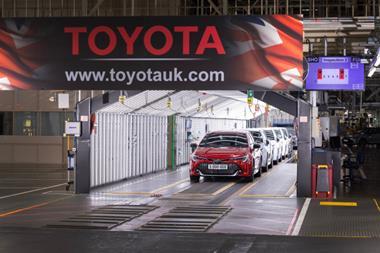As global trade intensifies, so do the risks associated with cyber-breaches, fraud and limited visibility for shippers to track and trace international shipments across the end-to-end supply chain. While digital connectivity introduces a whole new set of risks and potential disruptions to global trade, big data and industry stakeholders, breakthroughs in advanced IT platforms are certain to enhance collaboration, efficiency, security and transparency among global trading partners.
‘Digitise or Die!’ has become a popular quote among advocates of digitalisation after Nicholas Windpassinger’s book of the same name was published in January 2018, focusing on the merits and threats of the Internet of Things. Digitalisation is now a buzzword in supply chain circles, as companies look to improve operating platforms.
In an effort to promote supply chain transparency, cyber-security and transactional speed and efficiency, a new concept has arrived on the digital frontier: blockchain, a digital ledger that uses cryptocurrencies like bitcoin to authenticate trading partners along the end-to-end value exchange.
Behind the frenzied hype of cryptocurrency and the attention bitcoin has received in the financial markets, blockchain has emerged as a digital technology tool that can transform the logistics landscape. “Blockchain will revolutionise the industry from a security and traceability standpoint,” predicts William Ralph, a maritime economist with RK Johns & Associates.
Blockchain technology limits the transactional partners with secured access to pertinent data associated with a shipment or transaction. Players inside the blockchain consortium might include, but are not limited to: shippers, manufacturers, forwarders and intermediaries, port authorities, terminal operators, ocean carriers, landside transportation providers, freight forwarders, customs officials, financial institutions and the ultimate consignee.
Blockchain digitalisation introduces a new concept of offering shared documentation and transactional data to the stakeholders engaged in a shipment, while ‘blocking’ outsiders from manipulating or altering key data. Transactional parties can view and share critical ledgers, like bills of lading, invoices, terms and agreements which are applicable to a certain shipment or transaction. A ‘digital handshake’ among verified (or permitted) partners takes place along each step in the supply chain hand-off, mitigating the potential for cyber-intrusion.
According to a recent survey on challenges in the maritime shipping industry, which was jointly conducted by technology firm Navis and Business Performance Innovation Network, 82% of the 200 shippers, intermediaries, carriers, operators, and handlers surveyed agreed that supply chain visibility needs to improve.
Additionally, a recent PWC report indicated that digital implementation can create supply chain and manufacturing efficiencies of up to 4.1%, promoting agility and ultimately enhancing productivity and the customer experience across the value chain. According to the report, the goal of digitising the supply chain is “to fully integrate and make visible every aspect of the movement of goods”.
 Today, even in a highly technical environment, around half of maritime bookings and bills of lading are entered manually, creating errors on up to one-third of shipping invoices. These statistics were recently reported by Alphaliner, an international ocean container research and analytics organisation.
Today, even in a highly technical environment, around half of maritime bookings and bills of lading are entered manually, creating errors on up to one-third of shipping invoices. These statistics were recently reported by Alphaliner, an international ocean container research and analytics organisation.
With innovative blockchain contracts, secured participants will be able to offer accelerated approvals on transactions and avoid costly mistakes, particularly as blockchain technology improves in the near future.
Teaming up for cyber-safetyLast year, the malicious NotPetya virus infiltrated the operating systems of shipping icons FedEx and Maersk after an accounting software upgrade, costing AP Moller-Maersk an estimated $300m. Apparently in response to this cyber-attack, Maersk announced a new partnership with IBM in December 2017 that would use blockchain technology to digitise the logistics company’s operational platform, enhance cargo visibility and mitigate future data breaches across its end-to-end supply chain. AP Moller-Maersk will own 51% of the new venture and IBM will operate as the minority partner with 49% ownership.
For security purposes, pertinent transactional data is captured on decentralised personal computers, preventing hackers from accessing a centralised server. The cloud-based platform will create visibility among all partners in a transaction.
“This JV is fundamentally different from anything we’ve done at Maersk before,” said Mike White, head of global trade digitalisation for AP Moller-Maersk, during an ocean shipper’s panel at the Georgia Foreign Trade Conference in early February. A Maersk veteran, White will ultimately serve as CEO of the new partnership with IBM. “Make no mistake,” he commented. “The complete launch is going to be a journey.”
 "[The JV with IBM] is fundamentally different from anything we’ve done at Maersk before... This alliance will raise the platform of global shipping and benefit all carriers and forwarders." - Mike White, Maersk
"[The JV with IBM] is fundamentally different from anything we’ve done at Maersk before... This alliance will raise the platform of global shipping and benefit all carriers and forwarders." - Mike White, Maersk
The blockchain technology, branded Hyperledger Fabric 1.0, will provide a paperless system that will benefit “everyone in the shipping ecosystem,” White claimed, a view echoed by Maersk’s chief commercial officer, Vincent Clerc, who will serve as board chairman of the new joint venture with IBM.
Other ocean carriers are supportive of the initiative and recognise the long-term value of the blockchain proposition. “Whether it’s banks, customs, carriers or forwarders, we’ve recognised the need for real-time tracking,” commented George Goldman, president of Zim USA. “A cloud-based solution is the best channel for shared documentation.” Similar to AP Moller-Maersk, Zim is in discussions with an undisclosed partner to promote a digital and shared documentation platform with industry partners.
For years, the ability to track and trace goods, including vehicles and spare parts, along a global shipping route has eluded supply chain players, from OEMs, shippers and transportation intermediaries to consignees. However, new auto-identification technology can trace shipments, despite the mode of transit. Blockchain technology will complement and enhance track-and-trace, visibility and security as applications are unveiled.
Mike White sees the new venture as an open platform and believes it could ultimately be offered in a public forum. “The JV will be a completely different company and is not specifically a Maersk initiative,” he said. “This alliance will raise the platform of global shipping and benefit all carriers and forwarders.”
“A pilot program in 2017 created the need for improvements, resulting in a 2.0 version of the blockchain platform,” he said. IBM and Maersk must pass through a few regulatory hoops in establishing the JV and introducing the upgraded program, but final regulatory approvals are expected during 2018. “We’re excited to launch the final product by the fourth quarter,” stated White.
[mpu_ad]Yet IBM is certainly no stranger to forming joint ventures with other verticals to promote blockchain opportunities. Over the last six months, the company has partnered with other industries to introduce new blockchain software to the marketplace, for example in food/agriculture, real estate and banking/private equity. In an effort to promote food safety, IBM collaborated with JD.com and Wal-Mart to implement a blockchain application to improve tracking and tracing of food shipments in China.
IBM was one of the early members of Hyperledger, a consortium of providers that is promoting cross-industry initiatives in blockchain technology. Supported by the Linux Foundation, Hyperledger has been growing its membership – currently numbering 200 companies across supply chain, finance, manufacturing, and technology. In 2018 alone, 27 new enterprises have so far joined Hyperledger. The platform is building interest as an open-source effort designed to promote blockchain applications across industry sectors.
Digitalisation opens doors as others closeA host of other logistics companies have embraced the need to invest in digital technology, and blockchain applications appear to be the dominant focus.
Notwithstanding Trump administration threats on import tariffs and other policies which may impact on global trade and partnerships, digitalisation across trading lanes offers vast potential. Even before the emergence of digital technologies in logistics operations, a World Economic Forum report showed that global trade could increase by 15% if current barriers to trade could be reduced.
Besides the AP Moller-Maersk-IBM collaboration, a new partnership was also recently announced between third-party global intermediary Kuehne + Nagel and Temasek, a financial investment arm of the Singapore government. The two organisations signed a memorandum of understanding to invest in early-stage technology firms targeting improvements in supply chain operations.
“For Kuehne + Nagel [the venture] is both an important step in the deployment of our digitalisation approach and an effort to shape the future of our industry,” said Joerg Wolle, chairman of KN International, in a statement.
In other news, US supply chain technology newcomer Skuchain announced a partnership with Japanese technology giant NTT Data to engineer a blockchain system for the logistics industry. The platform allows for a blockchain-based track-and-trace system that uses mobile phones to enable RFID tracking along every transaction in the supply chain.
 "Whether it’s banks, customs, carriers or forwarders, we’ve recognised the need for real-time tracking. A cloud-based solution is the best channel for shared documentation." - George Goldman, Zim USA
"Whether it’s banks, customs, carriers or forwarders, we’ve recognised the need for real-time tracking. A cloud-based solution is the best channel for shared documentation." - George Goldman, Zim USA
“Initially, the goal of the partnership was to bring blockchain to Japan,” says Rebecca Liao, Skuchain’s head of business development and strategy. “But the platform has expanded beyond just Japan. NTT identified our platform as a viable blockchain technology and the partnership has grown across major industry sectors, including food safety, electronics, and among a few of Japan’s largest automotive manufacturers.”
Founded in 2014, Skuchain offers track-and-trace technology through blockchain software, recently expanding its platform into the fintech arena with an inventory-supported blockchain technology group branded with the trade name Inventory Management and Trading Services (IMT), a subsidiary company of Skuchain. “We have the ability to finance a supply chain transaction from a supplier’s inventory,” Rebecca Liao explains. “The buyer has visibility they didn’t have before and buyers get paid in real time.”
In addition to private partnerships among technology solution providers and global supply chain players, strategic industry alliances have been formed in anticipation of a continued surge in digitalisation.
The Blockchain in Transportation Alliance (BiTA) was formed in 2017 to interconnect progressive logistics and technology-related companies – and the effort to build collaboration appears to be working. The association now boasts over 200 industry partners who are implementing blockchain into their strategic logistics roadmap. “Another 350 transportation-centric groups have submitted applications to join the BiTA,” says Craig Fuller, co-founder of the emerging group.
Recently, Texas-based railroad BNSF became the first class-one rail operator to join BiTA. “Blockchain technology has the potential to change several aspects of the transportation industry and it’s important that the industry comes together to align around a set of standards,” stated Murru Murrugappan, BNSF’s vice-president of technology services and chief technology officer.
 Now, manufacturers are looking at ways to use digital technology to drive value and increase visibility in the automotive supply chain. “OEMs in the US are evaluating the business case for blockchain technology,” explains Skuchain’s Rebecca Liao.
Now, manufacturers are looking at ways to use digital technology to drive value and increase visibility in the automotive supply chain. “OEMs in the US are evaluating the business case for blockchain technology,” explains Skuchain’s Rebecca Liao.
A platform for future productionSupported by the emergence of digitalisation in the supply chain, a fourth industrial revolution is emerging worldwide. Known as industry 4.0, this next-generation manufacturing is supported by digital technologies such as big data, cloud-based storage, the Internet of Things, 3D printing, augmented reality – and now blockchain.
With digitalisation in its early stages of development, how long will it take to integrate along the end-to-end supply chain? According to Gartner, a premier supply chain consulting and research firm, full implementation of blockchain technology will take up to five years.
Meanwhile, in a recent Deloitte survey of supply chain professionals, 16% of respondents said the ‘digital model’ in supply chain management already exists. A PwC report also noted that 72% of manufacturing respondents in a recent report expected to integrate a digital outlay in five years’ time.
Once fully implemented, the impact of blockchain and other digital platforms will be significant, as 80% of participants in the Deloitte study said digitalisation will be the dominant factor in supply chain operations within five years.
“The automotive shipping industry faces disruptive changes ahead, including driverless vehicles, alternative fuel options and digitalisation,” predicts Mike Hynekamp, COO of WWL. “Blockchain and route optimisation are two factors that face the automotive shipping industry.”
What do all these changes mean for the customer, end consumer and the automotive supply chain? The ability to track goods digitally in real time across international borders is a benefit to all members of the automotive logistics sector. Ultimately, the efficient implementation of digitalisation through technology applications like blockchain will bring cost savings to the consumer.
Though the digital revolution is just beginning, participants along the value chain are embracing it. According to the Materials Handling Institute (MHI), an advocacy for US manufacturing and next-generation supply chain management, 47% of companies are yet to engage in a digital transformation plan, but the institute predicts that the digital economy will grow 10% annually. With supply chain digitalisation seen as the future of global enterprise, blockchain technology is positioned to explode.
Industry experts agree that 2017 was more of an experimental year for blockchain, but 2018 will bring real progress. As Skuchain’s Rebecca Liao states: “2018 is the year of live implementations in blockchain”.
 Future expenditures for blockchain models reveal the proliferation of digitalisation in supply chain management. Financial outlays for blockchain platforms were just under $100m in 2017 and are projected to be $2.1 billion in 2018, growing to $9.2 billion by 2021.
Future expenditures for blockchain models reveal the proliferation of digitalisation in supply chain management. Financial outlays for blockchain platforms were just under $100m in 2017 and are projected to be $2.1 billion in 2018, growing to $9.2 billion by 2021.
While other verticals continue to explore the benefits of digital and blockchain technology, the automotive sector is examining the implementation of tech applications across its supply chain. Automotive suppliers and OEMs simply can’t afford to ignore the attributes of increased visibility, security and streamlined efficiency associated with digital initiatives like blockchain technology.
As digitalisation continues its infiltration into the global supply chain, Skuchain’s Rebecca Liao holds out a challenge to automotive OEMs and suppliers: “Similar to the emergence of autonomous vehicles, we encourage the automotive industry to take a hard look at the benefits of blockchain technology. The sooner we embrace these changes, the better.”


































